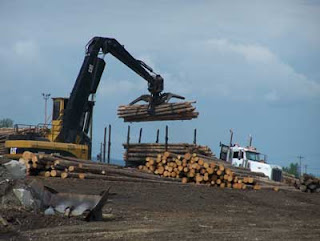Here’s a story from the Chetwynd International Chainsaw Competition (June 7 thru 10). The people, places, and activities are real, but the story is being made up by me (Warren). I say a good story of half truths is better that a bad story of all truths anytime…

Hi, I am Jarrette Dahl. I am on my way to Soldotna, Alaska where I will spend the summer working as a chainsaw carver. I planned my route from my home in Dawson, Minnesota to allow for attending this chainsaw carving competition. I guess it is pretty exclusive because it is by invitation only and limited to 12 competitors.

I am 21 years old, but I have found my passion in life. Well, I guess two passions, chainsaw carving and my girlfriend. She’s why I was a half hour late to the start and everyone else got a head start. No worries though, because I carve really fast and was ahead of the others in an hour. As a matter of fact I quit an hour early the first day, you know, I had to see my girlfriend.

I started the second day on time, but by lunch I was so far ahead of the others that I disappeared for a couple of hours. Had to go see my girlfriend, you know. As a matter of fact, she came back with me and helped. Then we left an hour before the others at the end of the day, you know, we had things to do, after all I am only 21.

This competition is fun. A lot of people gather in front of my area. I guess they like to watch me work because I am so fast. You know, one of the other competitors is 74 years old, I don’t know how he even lifts his chainsaw.

Well, the competition is over and this Japanese fellow won and walked away with $5,000 and a new chainsaw. Warren had picked him to win and me to be second, but I didn’t even get in the top three. Warren was shocked, but my girl friend will make it all right, besides I did get $1,000 in appearance money.
Here’s the second (left) and third place sculptures.


Hey catch ya later, and keep the trigger side in your hand and the sharp side in the wood.
Warren’s chainsaw artist friend,
Jarrette
PS There was a quick carve competition while the judges rated our sculptures. We had one hour. I carved two pieces and was started on my third. Most of the other guys didn’t even get their first piece completed. I got over $500 each for them at the auction after the show. All the pieces we carved for the main competition belong to the town (contest rules). So, stop in Chetwynd sometime and look at mine and the more than 60 other chainsaw sculptures on display from this and previous competitions.
 Spending many hours on the roadways leaves you open to delays. We've all been caught by this one. Often this involves waiting for the pilot car to lead you around the construction.
Spending many hours on the roadways leaves you open to delays. We've all been caught by this one. Often this involves waiting for the pilot car to lead you around the construction. Sometimes the pilot car is not what you were expecting. This mountain sheep lead us for several hundred yards and then tried to take us off-roading (I declined to follow).
Sometimes the pilot car is not what you were expecting. This mountain sheep lead us for several hundred yards and then tried to take us off-roading (I declined to follow). Here's a case where the flagger wanted to come over and chat, but I found it inappropriate to get out to talk. Actually I felt it was inappropriate even to leave the window down.
Here's a case where the flagger wanted to come over and chat, but I found it inappropriate to get out to talk. Actually I felt it was inappropriate even to leave the window down. Sometimes a young person (or caribou) wants to cross the street. In most states pedestrians have the right of way, so I stopped.
Sometimes a young person (or caribou) wants to cross the street. In most states pedestrians have the right of way, so I stopped.




































